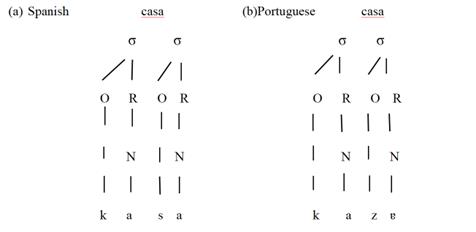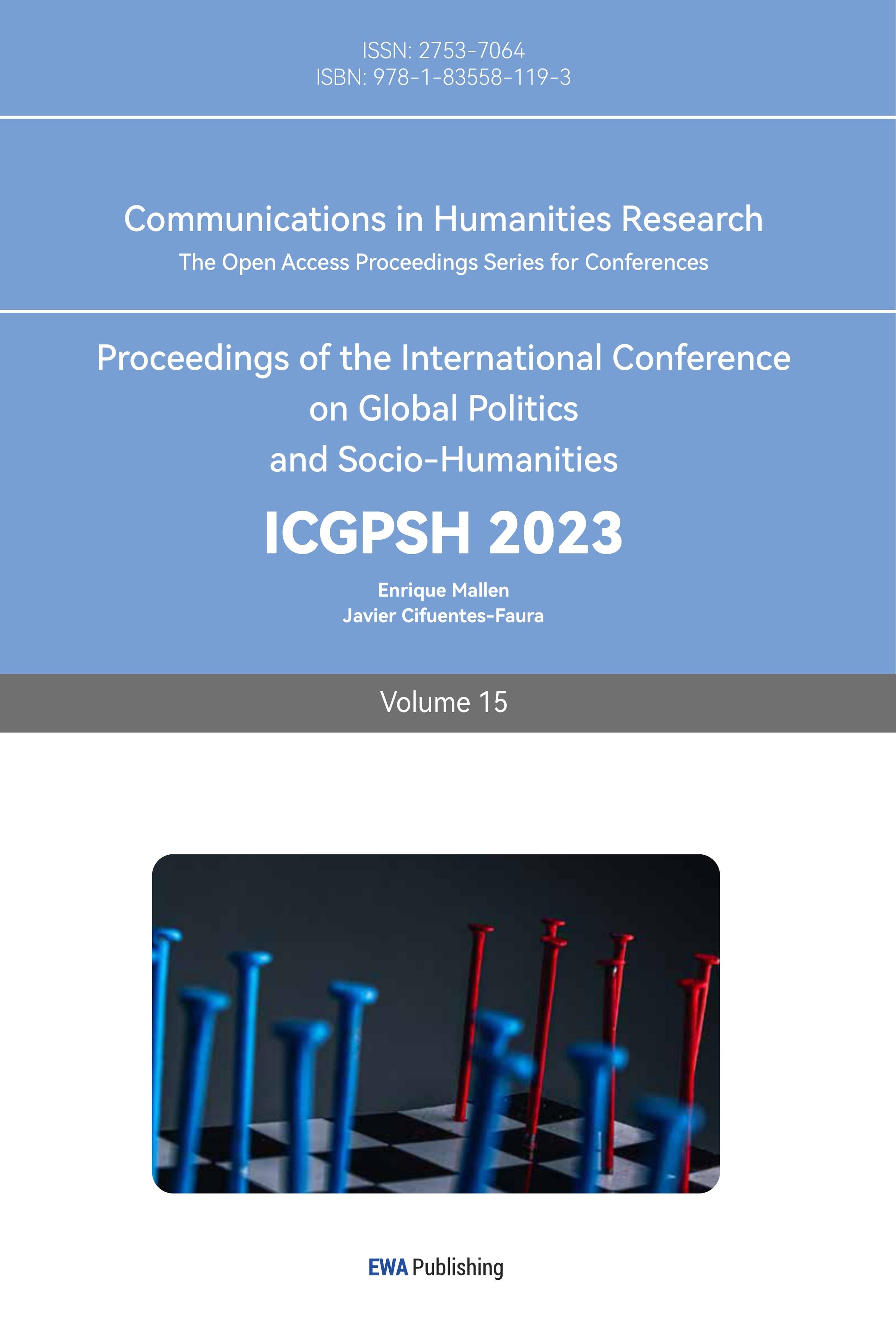1.Introduction
The paper will briefly explain the Spanish language system, revolving five perspectives, so that the readers have a general understanding of it. It is an unavoidable topic to know about multiple languages when people research linguistic. There are a lot of papers and articles that are devoted to the study of a particular aspect of linguistic problems professionally. That benefit the related researchers get deep and detailed understanding of linguistic and support many of their arguments. But on the other hand, there is a lack of formal academic papers to generally describe the fundamental system of the language Spanish and compare it with a language that is extremely close resemble to Spanish, Portuguese. Instead, the most of whom introduce that is some popular science and knowledge website, which is short of formal and academic guarantee. Hence this paper would like to provide an entry-level integrated introduction and analysis of Spanish language system, assisting the readers preliminarily know about Spanish or conduct their following research more conveniently.
2.Main Body
From the perspective of geography, it is shown that Spanish is widely spoken around the world. Besides Europe, Spanish is also used in America and Africa. According to Samanphyli, Spanish is used as the official language in twenty-one countries [1]. Sala and Posner mentioned that Spanish is growing there even though many people in South and Central America speak native Indian languages as their first language [2].
In terms of human, the above geographical data has been verified. Erichsen stated that over four hundred million people is born with Spanish as their first language, which make it the second-most widely used tongue in the world [3]. Spanish is a language that does not suffer from generational problems. Because of its prestige, more and more non-native Spanish speakers who might come from immigrant regions or had a minority language as their mother tongue, continuously became Spanish speakers (Ramallo) [4]. Spanish is also the most common spoken language of the bilingual learner family (Rojas) [5]. That means that the language system of Spanish is acceptable for most people in the world and shares much similarity with many other languages.
With such a wide range and such a large number of speakers, Spanish is bound to have many internal dialectal divisions. A group of Spanish brought their regional accents to America, so different regional accents of Spanish emerged in America. People can find five different languages in Spain, they are Castilian, Galician, Gascony, Catalan and Basque. They have some differences in phonology. Among them, Castilian is considered as the standard pronunciation in Spanish and be used by the most people. Castilian was originally spoken in northern Spain. After the Reconquista in 1492, it spread to the southern Spain. Basque is even not belonging to Spanish language system.
Back to Spanish itself, it has one more vowel than some typical languages like English and Chinese. Spanish belongs to the world’s largest language family, Indo-European languages and is further classified as a Romance language. The main origins of Spanish vocabulary contain Latin and Classical Greek. And Brodsky stated that there were about ninety percent of Spanish words relevant to corresponding English words, which promoted the richness of Spanish vocabulary sources [6]. Other languages of Romance language include French, Italian, Portuguese, Romanian and so on. And in Romance language family, Spanish and Portuguese have the highest similarity.
Therefore, the comparison between Spanish and Portuguese is a good example to reveal the characters of Spanish. The two languages are 89% similar in morphology. For example, according to Table 1, the word pairs in the table may have different meanings but they all have the same appearances. It is worth mentioning that the word pairs that have the same looks and sound but different meanings are called false cognates or false friend such as the third, fourth and fifth pair in Table 1. They do not have the same origins but appear as the same just accidentally (Put) [7].
Table 1: Comparison between Spanish and Portuguese in morphology.
SPANISH | PORTUGUESE |
Gato(cat) | Gato(cat) |
Mundo(world) | Mundo(world) |
Topo(mole) | Topo(top) |
Polvo(dust) | Polvo(octopus) |
Rojo(red) | Rojo(purple) |
In phonology, there are some obvious differences for us to explore. The phonemes of Spanish are divided into two parts to research. The first part is the vowels. Portuguese vowels are usually reduced when they are unstressed at the end of the word, but Spanish vowels are fully pronounced (Jorgensen) [8]. According to Figure 1 made by the author, the word casa, which exists in both Spanish and Portuguese, is a typical example to explain that.

Figure 1: Syllable structure of the contrasting words.
According to the phonetic tables of Spanish and Portuguese, it is known that Portuguese have 5 more nasal vowels than Spanish. The vowels of it become nasalized when followed by a nasal consonant like n. The word cantar both in Spanish and Portuguese is an example for this difference. In the same way, because Portuguese has more vowels than Spanish on the whole, it also has more diphthongs. So, it is like Koyfman said, a Portuguese speaker usually feels it easy to learn Spanish but Spanish speakers can just understand Portuguese well on the premise that the Portuguese is slowly spoken [9].
The other part is the consonants. The phonemes /b/, /d/ and /g/ are plosives in IPA. Jorgensen also mentioned that in Spain people pronounce them in a soft way, but in Portuguese they have plosive and soft palatalization part in consonants [8]. And for Spanish, all the consonants at the ends of words are required to be coronal. The words saber and nada in Spanish and Portuguese represent that distinctly. The sound of r is a particular case to show their difference. When r is doubled or at the beginning of words, it will change its sounds in Portuguese. But in Spanish they do not have this rule. When people say the word torre respectively in Spanish and Portuguese, the listeners can feel the difference apparently. The last difference is caused by the absence of 4 consonants in Spanish compared with Portuguese. They are /ʃ/, /ʒ/, /v/ and /z/. Jorgensen elaborated that the v in Spanish tends to sounds like the softened b rather than v, but Portuguese has a clear pronunciation of the v [8]. The word visitar in these two languages and libro in Spanish and livro in Portuguese present the above description. The z sound in Portuguese is often seen but in Spanish it is not. That is related to the difficulty of Spanish to produce the voiced fricative. The voiced [z] and voiceless [s] sound are both the alveolar fricative in Portuguese but they have different phonological effect. For example, casa - caça and rasa– raça, of whom initial sounds are generated with the voiced fricative, are the minimal pairs to evidence that. In contrast to Spanish, where there is no phonological difference between the voiced and voiceless equivalents of the alveolar fricative (Alves and Brisolara) [10]. The word preciso in the two languages represents that the z sound in Spanish turned voiceless but in Portuguese z is pronounced normally.
3.Conclusions
From the perspectives of geography, human, dialect, identity and comparison, the language system of Spanish shows a clearer picture and a general phonology impression. Spanish owns an extremely high degree of spread and a wide range of speakers, which means the study of it can generate much benefit. Its diversified origins, rigorous language system and the richness of similar languages decide that it has great reference value in linguistic research. At the same time, according to the comparison between the two similar languages, Spanish and Portuguese, it is obvious that Portuguese has more variety and complex pronunciation rules than Spanish. Therefore, not only Spanish can reflect and represent many characters of the Romance family with its identity as a Romance language, but Spanish is also easier for the linguistic researchers to conduct an experiment and summarize rules. That all indicates that Spanish is a good choice for the linguistic learners to experience, feel and research the laws of linguistic.
References
[1]. Samanphyli. (2023). 20 Fun Facts About Spanish that Will Surprise You. Retrieved from https://www.fluentu.com/blog/spanish/facts-about-spanish/.
[2]. Sala, M. and Posner, R. (2023). Spanish language. Encyclopedia Britannica. Retrieved from https://www.britannica.com/topic/Spanish-language
[3]. Erichsen, G. (2020). 10 Facts About the Spanish Language. ThoughtCo, thoughtco.com/spanish-language-facts-4136754.
[4]. Ramallo, F. (2018). Linguistic diversity in Spain. 10.1515/9783110365955-018.
[5]. Rojas, N. M. (2020). American Psychological Association. Retrieved from https://dx.doi.org/10.1037/edu0000481
[6]. Brodsky, D. (2008). 1.1. Spanish as a Romance Language. In Spanish Vocabulary: An Etymological Approach (pp. 17-20). New York, USA: University of Texas Press.
[7]. Put, O. (2021). Spanish vs Portuguese: Similarities and Differences. Retrieved from https://www.spanish.academy/blog/spanish-vs-portuguese-similarities-and-differences/
[8]. Jorgensen, P. (2016). How Similar are Spanish and Portuguese. Langfocus.
[9]. Koyfman, S. (2017). Learn One Romance Language, Learn Them All. Retrieved from https://www.babbel.com/en/magazine/learn-one-romance-language-learn-them-all
[10]. Alves, U. K., & Brisolara, L. B. (2020). Listening to accented speech in Brazilian Portuguese: On the role of fricative voicing and vowel duration in the identification of /s/ – /z/ minimal pairs produced by speakers of L1 Spanish. Journal of Portuguese Linguistics, 19: 6, 1–23.
Cite this article
Zheng,H. (2023). The Spanish Language System from Muti-dimensional Perspectives. Communications in Humanities Research,15,114-117.
Data availability
The datasets used and/or analyzed during the current study will be available from the authors upon reasonable request.
Disclaimer/Publisher's Note
The statements, opinions and data contained in all publications are solely those of the individual author(s) and contributor(s) and not of EWA Publishing and/or the editor(s). EWA Publishing and/or the editor(s) disclaim responsibility for any injury to people or property resulting from any ideas, methods, instructions or products referred to in the content.
About volume
Volume title: Proceedings of the International Conference on Global Politics and Socio-Humanities
© 2024 by the author(s). Licensee EWA Publishing, Oxford, UK. This article is an open access article distributed under the terms and
conditions of the Creative Commons Attribution (CC BY) license. Authors who
publish this series agree to the following terms:
1. Authors retain copyright and grant the series right of first publication with the work simultaneously licensed under a Creative Commons
Attribution License that allows others to share the work with an acknowledgment of the work's authorship and initial publication in this
series.
2. Authors are able to enter into separate, additional contractual arrangements for the non-exclusive distribution of the series's published
version of the work (e.g., post it to an institutional repository or publish it in a book), with an acknowledgment of its initial
publication in this series.
3. Authors are permitted and encouraged to post their work online (e.g., in institutional repositories or on their website) prior to and
during the submission process, as it can lead to productive exchanges, as well as earlier and greater citation of published work (See
Open access policy for details).
References
[1]. Samanphyli. (2023). 20 Fun Facts About Spanish that Will Surprise You. Retrieved from https://www.fluentu.com/blog/spanish/facts-about-spanish/.
[2]. Sala, M. and Posner, R. (2023). Spanish language. Encyclopedia Britannica. Retrieved from https://www.britannica.com/topic/Spanish-language
[3]. Erichsen, G. (2020). 10 Facts About the Spanish Language. ThoughtCo, thoughtco.com/spanish-language-facts-4136754.
[4]. Ramallo, F. (2018). Linguistic diversity in Spain. 10.1515/9783110365955-018.
[5]. Rojas, N. M. (2020). American Psychological Association. Retrieved from https://dx.doi.org/10.1037/edu0000481
[6]. Brodsky, D. (2008). 1.1. Spanish as a Romance Language. In Spanish Vocabulary: An Etymological Approach (pp. 17-20). New York, USA: University of Texas Press.
[7]. Put, O. (2021). Spanish vs Portuguese: Similarities and Differences. Retrieved from https://www.spanish.academy/blog/spanish-vs-portuguese-similarities-and-differences/
[8]. Jorgensen, P. (2016). How Similar are Spanish and Portuguese. Langfocus.
[9]. Koyfman, S. (2017). Learn One Romance Language, Learn Them All. Retrieved from https://www.babbel.com/en/magazine/learn-one-romance-language-learn-them-all
[10]. Alves, U. K., & Brisolara, L. B. (2020). Listening to accented speech in Brazilian Portuguese: On the role of fricative voicing and vowel duration in the identification of /s/ – /z/ minimal pairs produced by speakers of L1 Spanish. Journal of Portuguese Linguistics, 19: 6, 1–23.









